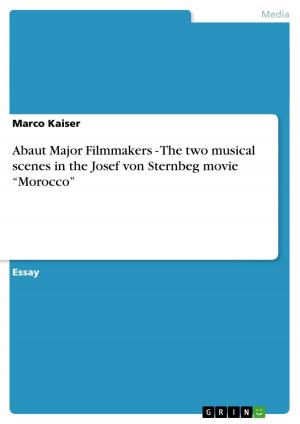Beckett on Web 2.0
Damned to fail...fail better
Nonfiction, Reference & Language, Language Arts, Linguistics| Author: | Eike Rüdebusch | ISBN: | 9783640619689 |
| Publisher: | GRIN Publishing | Publication: | May 11, 2010 |
| Imprint: | GRIN Publishing | Language: | English |
| Author: | Eike Rüdebusch |
| ISBN: | 9783640619689 |
| Publisher: | GRIN Publishing |
| Publication: | May 11, 2010 |
| Imprint: | GRIN Publishing |
| Language: | English |
Seminar paper from the year 2009 in the subject Speech Science / Linguistics, grade: 1,0, University of Siegen (Sprach-, Literatur- und Medienwissenschaften), course: Samuel Beckett - Playwright, Novelist and Writer for the TV-Screen, language: English, abstract: Samuel Beckett certainly was one of the most important artists of the 20th century. His literature and drama changed the way people perceive arts and the tragic of human existence, further the way media displays them. Although Beckett was rigid regarding the realisation of his plays he was very open towards new media and techniques. He was up to date and wrote plays for the theatre, the radio and even for television. But he died before he could have used the possibilities the internet offers nowadays. Nevertheless, Beckett is omnipresent in today?s internet. You just have to type his name into Google and you will find 1.470.000 hits referring to him.1 Especially his presence on Youtube, a video community on the internet, is astonishing. There people have found many ways to adapt one or several of Beckett?s works the way they wanted to. One could raise the question if this was what Beckett wanted, if this could have been avoided or if this was part of a logical consequence of the technological progress and the developments the internet has gone through within the last decade. Having Paul Virilio?s media theory in mind, the Aesthetics of Disappearance, in which he argues about the speed of information and the transformation of media, there is always a next step in terms of media, which in the end has led to the internet as it is today. Beckett always took that next step himself. Therefore, Beckett being part of the internet is the logical consequence of his work, of the way he used or was intrigued by different media, of the way he brought art to the latest medium - or is it not? Throughout this paper I will argue that Beckett?s work Play needed to be placed on the internet. I will try to prove that Play can make use of its full potential only within Web 2.0. I will start by reconstructing the media-history Play has gone through, from text to stage, from radio to television play. By doing that, I will point out that Beckett has always included another medium?s potentials and techniques when adapting Play. Then, I will continue with Play on Web 2.0. I will describe what Web 2.0 actually means and where it came from, in order to later analyse Play on the internet, theoretically and aesthetically to finally conclude if Play really is best adapted on the internet.
Seminar paper from the year 2009 in the subject Speech Science / Linguistics, grade: 1,0, University of Siegen (Sprach-, Literatur- und Medienwissenschaften), course: Samuel Beckett - Playwright, Novelist and Writer for the TV-Screen, language: English, abstract: Samuel Beckett certainly was one of the most important artists of the 20th century. His literature and drama changed the way people perceive arts and the tragic of human existence, further the way media displays them. Although Beckett was rigid regarding the realisation of his plays he was very open towards new media and techniques. He was up to date and wrote plays for the theatre, the radio and even for television. But he died before he could have used the possibilities the internet offers nowadays. Nevertheless, Beckett is omnipresent in today?s internet. You just have to type his name into Google and you will find 1.470.000 hits referring to him.1 Especially his presence on Youtube, a video community on the internet, is astonishing. There people have found many ways to adapt one or several of Beckett?s works the way they wanted to. One could raise the question if this was what Beckett wanted, if this could have been avoided or if this was part of a logical consequence of the technological progress and the developments the internet has gone through within the last decade. Having Paul Virilio?s media theory in mind, the Aesthetics of Disappearance, in which he argues about the speed of information and the transformation of media, there is always a next step in terms of media, which in the end has led to the internet as it is today. Beckett always took that next step himself. Therefore, Beckett being part of the internet is the logical consequence of his work, of the way he used or was intrigued by different media, of the way he brought art to the latest medium - or is it not? Throughout this paper I will argue that Beckett?s work Play needed to be placed on the internet. I will try to prove that Play can make use of its full potential only within Web 2.0. I will start by reconstructing the media-history Play has gone through, from text to stage, from radio to television play. By doing that, I will point out that Beckett has always included another medium?s potentials and techniques when adapting Play. Then, I will continue with Play on Web 2.0. I will describe what Web 2.0 actually means and where it came from, in order to later analyse Play on the internet, theoretically and aesthetically to finally conclude if Play really is best adapted on the internet.















